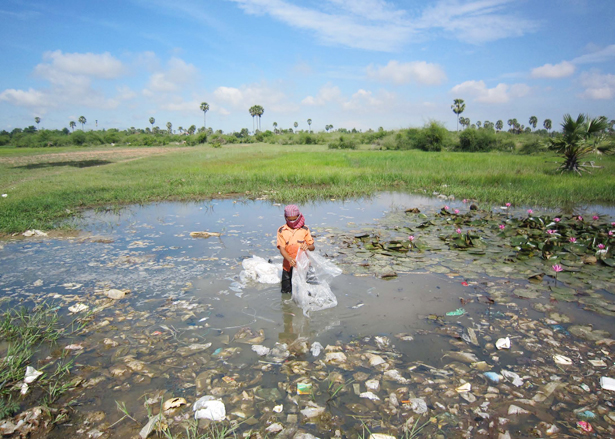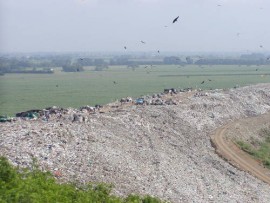Source #5
Industrial/Municipal Dumpsites
Description
Waste at industrial or municipal dumpsites can include waste from batteries, scrap metal, agricultural, and hospitals, households and chemical waste from industrial processes. In the developing world, all waste often goes into the same place, there is often no difference between municipal and industrial dumpsites, Polluted dumpsites generally consist of two different types of waste disposal, open dumpsites and municipal landfills. Open dumpsites are unregulated informal sites where individuals or industries dump a variety of solid or liquid waste with no formal treatment or pollution controls. They may be unsanctioned or informally accepted by the government but likely there are no standards for treatment or control of waste, and little control over what types of wastes are dumped. Municipal landfills may be operated by the government or a private entity but are often poorly constructed and employ only limited measures for protection against pollution. In addition, abandoned municipal sites are often not properly capped or covered to prevent pollution.

There are almost 150 industrial or municipal dumpsites in the Blacksmith Institute’s database that are polluting local communities, potentially putting almost 3.5 million people at risk. The largest shares of these dumpsites are in Africa and in Eastern European and Northern Asian countries. Combined, these regions make up more than half of the total at risk population in the Blacksmith investigations of dumpsites. However, industrial and municipal dumpsites are prevalent throughout the developing world including in South and Central America and South and Southeast Asia.
At properly run municipal solid waste landfills, hazardous materials considered carcinogenic, corrosive, toxic, or flammable are not accepted and are directed to special treatment or disposal sites.[1] At informal or improperly run sites, all these items are disposed together, creating a toxic stew of waste exposed to heat, rain and air, causing the materials to break down and easily enter the environment. Industrial waste is one of the most toxic wastes at dumpsites and makes up a large portion of the pollution problem at the dumpsites investigated by Blacksmith.
Exposure Pathways
The main sources of pollutants from dumpsites are either leachate (contaminated liquids leaching into the groundwater), dust from poorly covered or controlled landfills and landfill gas that is not captured.[2] Leachate can contain heavy metals, VOCs or hazardous organic compounds. These pollutants are carried into aquifers or surface waters. Dust from dumpsites may contain metals and human pathogens that come into contact with this pollution through contaminated groundwater and soil, or direct contact with the waste site.[3] Children often are seen playing in and around dumpsites, introducing direct exposure with hazardous waste through dermal contact, inhalation of dust or accidental ingestion. Informal neighborhoods are often built on top of previous dumpsites where the soil, groundwater and nearby surface waters are contaminated, indirectly exposing the local population to leached pollutants. A notable issue with dumpsites in the developing world is the presence of scavengers - workers and their families at dumpsites who make their living by recovering economically valuable materials in the waste. In such situations, people come into direct contact with the contaminants at the waste site.
Top Pollutant(s)
In the Blacksmith Institute’s database of industrial or municipal dumpsites the most pervasive and harmful pollutants are lead and chromium. Combined they are the key pollutants in a third of the sites, potentially affecting almost 1.2 million people. The health impacts of these pollutants have been covered in this report and include lung cancer, neurological problems and cardiovascular disease. Other pollutants in the database of dumpsites include cadmium, multiple types of pesticides, and arsenic and VOCs.
Global Burden of Disease
Blacksmith Institute estimates that exposure to lead from industrial and municipal dumpsites results in 1.2 million DALYs. Chromium only contributes a fraction of this total; in the sites investigated by Blacksmith Institute lead was the predominant pollutant.
What is being done?
Ongoing international support to encourage governments to upgrade sanitary landfill sites could be expanded to address polluted dumpsites and prevent future unsafe dumping. Organizational and financial issues are a fundamental challenge in improving waste management performance in many countries. The technology for secure industrial landfills is well established in many developing countries but weak regulation often means that many industries take the cheaper option of dumping.
Many low-cost methods exist for reducing the impacts of pollution from industrial dumping. At a site in India over 60,000 tons of industrial waste had been dumped over the last decade. Several toxic components had leaked into the groundwater, turning local streams red and spreading contaminated materials through monsoon rains. Working closely with local industrialists, through the Gujarat Industrial Development Corporation (GIDC), a staged cleanup was implemented. The main core of hazardous wastes were removed and taken to a proper disposal facility. Blacksmith then funded the implementation of a low-tech bioremediation approach that included treating the remaining contaminated site with vermiculture – worms – that concentrate heavy metals in their bodies and reduce the contamination in the soil around them. Over several seasons of treatment with this innovative approach, the site continues to show a reduction of heavy metals, which are now at acceptable levels. This low-cost pilot bio-remediation method has proved highly effective.
Footnotes:
[1] Allen, A.R., Taylor, R. ‘Waste disposal and landfill: Control and protection.” Protecting Groundwater for Health: Managing the Quality of Drinking-water Sources, WHO Drinking Water Quality Series Monograph,IWA Publishing. 2006.
[2] Johannessen, L.M. et al. “Observations of Solid Waste Landfills in Developing Countries: Africa, Asia and Latin America.” The World Bank Group, Urban Development Division. 1999.
[3] Ibid. 32

-
Source #1
Battery Recycling
-
Source #2
Lead Smelting
-
Source #3
Mining and Ore Processing
-
Source #4
Tanneries
-
Source #5
Industrial/Municipal Dumpsites
-
Source #6
Industrial Estates
-
Source #7
Artisanal Gold Mining
-
Source #8
Product Manufacturing
-
Source #9
Chemical Manufacturing
-
Source #10
Dye Industry
-
The Remaining Five Sources



